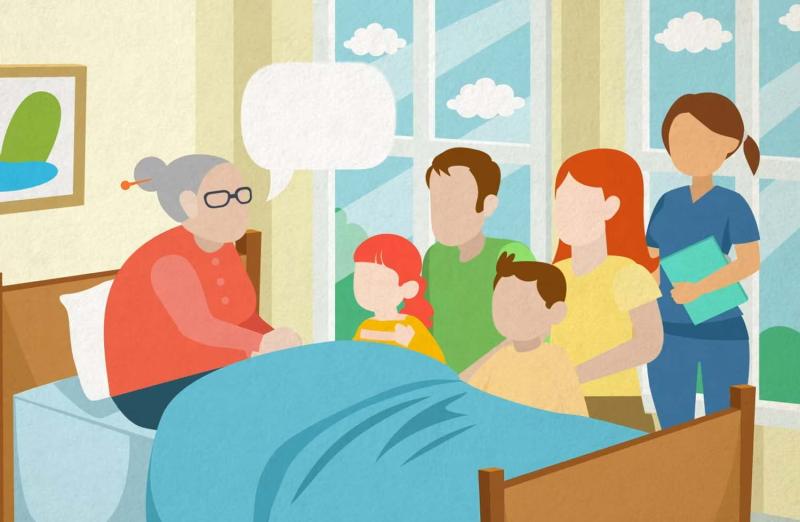Key points
- Emergency department visits and hospital admissions are common for people in residential aged care nearing the end of their lives. This may not always be in their best interests, necessary, or align with their preferences for end-of-life care.
- The reasons why people are transferred to acute care settings at the end of life are complex but often reflect family wishes and the availability of clinical staff with the skills to assess if an escalation of medical care is needed.
- Acute care transfers can result in adverse outcomes for people, such as hospital-acquired infections, pressure ulcers, delirium, and increasing functional decline.
- People living with advanced dementia often find transfers from the familiar home or residential aged care setting to a hospital distressing.
- The rate of acute care transfers might be reduced by increasing the number of residents with advance care plans, providing care staff with improved access to Nurse Practitioners experienced in palliative care, implementing regular medication reviews by clinical pharmacists, and having specialist palliative care consultations and geriatrician assessments.
People near the end of life may be transferred between their home —in a residential aged care facility—and an emergency department or hospital ward. [1] Although the rates of acute care transfers vary across countries, [2, 3] an estimated 25%-70% of Australian aged care residents who are at the end of life are hospitalised. [1] The frequency of acute care transfers often increases closer to death, [2] with one-third of residents being hospitalised within the last month of life. [3] Transfers may be a necessary response to a medical crisis such as a cardiovascular event, a fall, an infection or an uncontrolled pain or symptom burden. [2] However, it may be more appropriate for people to be treated by nurses and General Practitioners in a familiar setting (in their homes).
This evidence theme on acute care transfers near the end of life summarises one of the key topics identified by a scoping review of the palliative care research. If you need more specific or comprehensive information on this topic, try using the PubMed search below.
We identified twelve reviews on this topic. [1-12] These examined rates of transfers near the end of life, the factors influencing decisions to transfer a resident, likely outcomes of transfers, and strategies that facilities have trialled to reduce the number of inappropriate, non-beneficial transfers.
Why do acute care transfers occur at the end of life?
Decisions to transfer people to an emergency department near the end of their life can be difficult and may be influenced by a range of personal, organisational, and policy factors. [2] Firstly, people approaching the end of life tend to have more complex care needs due to their increased frailty, multimorbidity, and the use of multiple medications. [2, 11, 12] This complexity can make hospitalisation or an emergency department visit unavoidable when the expected benefits outweigh the potential burden on the resident. [3] Australian residential aged care facilities are mostly staffed by direct care workers, with few Registered Nurses available to clinically assess a person’s needs. Staff on duty may not have the skills to determine if a resident is approaching the end of life or if care might be provided in the home. They may also lack timely access to clinicians or palliative care specialists to support decision-making, especially after hours. Therefore, transferring to acute care is often considered the safest action when a person’s required care exceeds staff capabilities, or there are limitations in accessing appropriate equipment or medications within the facility. [5] Family members also might request a higher level of medical care for their loved ones if they notice signs of deterioration or if they have concerns about the quality of medical care at hand. [2]
Common reasons for acute care transfers include:
- Respiratory or urinary tract infections
- Falls, particularly when leading to fractures
- Cardiovascular illnesses such as heart failure
- Altered mental states such as delirium
- Complications with permanent indwelling devices (e.g., percutaneous endoscopic gastrostomy tube or catheter)
- Chronic pain
- Drug-related complications. [7]
Why are acute care transfers sometimes best avoided?
High demand in Emergency Departments can mean older people experience long wait times to receive care past that provided by Paramedics. [10] Aged care residents arriving at Emergency Departments from facilities experience increased wait times for medical attention compared with older people dwelling within the community, with over 37% of residents waiting over eight hours to be seen. [7] Those residents most unwell on arrival tend to wait the longest of all, [7] and between 1-5% of older people will die in the Emergency Department. [7]
In comparison to community-dwelling older people, residents of aged care facilities also experience higher rates of invasive and uncomfortable diagnostic and treatment interventions in the Emergency Department. [7] This can include blood tests and the insertion of an intravenous cannula or indwelling urinary catheter. [7] Around 85% of people transferred near the end of their lives will have diagnostic imaging involving them moving between beds and hospital departments. A majority will also be given medications with the potential to cause adverse drug reactions. [7]
In acute care settings, older people approaching the end of life are also at increased risk of developing malnutrition, skin tears, hospital-acquired infections, pressure ulcers, delirium, and increasing functional decline. [1, 5] They also have a higher risk of dying in these settings, [3, 13] often not aligning with their wishes. [9] People living with dementia can experience a high level of distress when transferred to an Emergency Department or after hospital admission. However, aged care residents living with dementia are often less likely to be hospitalised and receive aggressive treatment at the end of life when compared to people living without dementia. [6]
When might a transfer be inappropriate?
Transferring someone from their home environment to an acute care facility may be inappropriate when:
- Issues can be adequately treated or prevented from occurring within the aged care setting. [8]
- The person has an advance care plan or advance directive in place requesting limited treatment at the end of life. [8]
- Levels of personal discomfort or confusion likely to be caused by a transfer outweigh the probable benefits of the move to acute care. [8]
- The person is unlikely to benefit from any further active treatment. [8]
Reducing acute care transfers near the end of life
Most reviews reported an association between residential aged care facilities with staff competent in palliative care or able to access specialist nurse expertise and reduced rates of transferring residents approaching the end of life to acute care settings. [3-6, 10] One review identified late transfers and hospital admissions were reduced by 7% when facility staff had access to an experienced palliative care nurse who modelled effective end-of-life care to other staff. [10] For people living with advanced dementia, consultations by Nurse Practitioners with palliative care experience reduced transfers by addressing goals of care and symptom management. [10] Earlier palliative care consultations also appear more effective than those conducted later, with emergency visits halved when consultations occur one to two months before the resident’s death. [10] Hospitalisation rates were also reduced for residents with advance care plans or advance directives in place. [1, 3, 7] Educational programs providing aged care staff with training in discussing and documenting end-of-life care wishes might, therefore, effectively contribute to reducing unnecessary transfers. [9]
The reviews identified several other factors capable of reducing hospital transfers. These include:
- Higher staff-to-patient ratios. [7]
- Greater availability of, or access to, skilled residential aged care nursing and clinical staff, including Nurse Practitioners, General Practitioners, and specialist geriatricians. [3, 7, 9]
- Substitute decision-makers with a high level of understanding of the clinical trajectory of advanced dementia. [7]
- Regular residential care medication reviews by clinical pharmacists. [9]
Some reviews, however, highlighted concerns about the methods used in some studies. For example:
- Evidence quality was generally weak for interventions aimed at reducing transfers, which may undermine confidence in some of the findings. [9]
- The effect of facility site and staffing numbers was often unclear. This is important as there is some evidence that facilities with more nursing staff and access to clinicians have lower rates of hospitalisations. [1]
The results have informed this evidence theme of a scoping review intended to map the published research in this area. Our findings reflect the current state of the evidence, which we note is limited in breadth and quality.
- Nurses and doctors working in-home or residential aged care can proactively discuss hospitalisation preferences with residents and their families.
- Be informed about advance care planning and open to opportunities to discuss these plans with aged care recipients.
- Aged care workers with little or no palliative care experience might undertake a short course or complete an online learning module to recognise deterioration and how to provide care to residents who are approaching or are at the end of life within a residential aged care setting.
Aged care staff require skills in assessing and managing residents within the facility. Organisations should therefore:
- Provide or facilitate education and training for all aged care staff on recognising and effectively reporting deterioration and how to provide care to residents approaching the end of life.
- Plan and implement processes such as management protocols for reducing unplanned acute care transfers for people approaching the end of life. This may include greater involvement of palliative care consultants or the introduction of Palliative Care Needs Rounds, which have been shown to reduce hospital transfers.
- Consider implementing a system application, such as the ELDAC digital dashboard, which tracks the end-of-life care needs of residents, flags signs of deterioration, and uses prompts to guide the care of the dying person.
- Ensure residents have access to routine medication reviews, which have been shown to reduce transfers for medication-related problems.
Resources related to acute care transfers
- Pimsen A, Kao CY, Hsu ST, Shu BC. The effect of advance care planning intervention on hospitalization among nursing home residents: A systematic review and meta-analysis. J Am Med Dir Assoc. 2022;23(9):1448-1460.e1441.
- Pulst A, Fassmer AM, Schmiemann G. Experiences and involvement of family members in transfer decisions from nursing home to hospital: A systematic review of qualitative research. BMC Geriatr. 2019;19(1):155.
- Allers K, Hoffmann F, Schnakenberg R. Hospitalizations of nursing home residents at the end of life: A systematic review. Palliat Med. 2019;33(10):1282-1298.
- Hoffmann F, Strautmann A, Allers K. Hospitalization at the end of life among nursing home residents with dementia: A systematic review. BMC Palliat Care. 2019;18(1):77.
- Laging B, Bauer M, Ford R, Nay R. Decision to transfer to hospital from the residential aged care setting: A systematic review of qualitative evidence exploring residential aged care staff experiences. JBI Evidence Synthesis. 2014;12(2).
- Williamson LE, Evans CJ, Cripps RL, Leniz J, Yorganci E, Sleeman KE. Factors associated with emergency department visits by people with dementia near the end of life: A systematic review. J Am Med Dir Assoc. 2021;22(10):2046-2055.e2035.
- Dwyer R, Stoelwinder J, Gabbe B, Lowthian J. Unplanned transfer to emergency departments for frail elderly residents of aged care facilities: A review of patient and organizational factors. J Am Med Dir Assoc. 2015;16(7):551-562.
- Cardona-Morrell M, Kim JCH, Brabrand M, Gallego-Luxan B, Hillman K. What is inappropriate hospital use for elderly people near the end of life? A systematic review. Eur J Intern Med. 2017;42:39-50.
- Buck D, Tucker S, Roe B, Hughes J, Challis D. Hospital admissions and place of death of residents of care homes receiving specialist healthcare services: A systematic review without meta-analysis. J Adv Nurs. 2022;78(3):666-697.
- Leduc S, Cantor Z, Kelly P, Thiruganasambandamoorthy V, Wells G, Vaillancourt C. The safety and effectiveness of on-site paramedic and allied health treatment interventions targeting the reduction of emergency department visits by long-term care patients: Systematic review. Prehosp Emerg Care. 2021;25(4):556-565.
- Yorganci E, Sampson EL, Gillam J, Aworinde J, Leniz J, Williamson LE, et al. Quality indicators for dementia and older people nearing the end of life: A systematic review. J Am Geriatr Soc. 2021;69(12):3650-3660.
- Mitchell RJ, Wijekulasuriya S, du Preez J, Lystad R, Chauhan A, Harrison R, et al. Population-level quality indicators of end-of-life-care in an aged care setting: Rapid systematic review. Arch Gerontol Geriatr. 2024;116:105130.
- Bone AE, Evans CJ, Etkind SN, Sleeman KE, Gomes B, Aldridge M, et al. Factors associated with older people's emergency department attendance towards the end of life: A systematic review. Eur J Public Health. 2019;29(1):67-74.
Connect to PubMed evidence
This PubMed topic search is limited to home care and residential aged care settings. You can choose to view all citations or citations to articles available free of charge.


